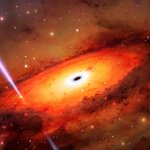Space

One of the things that keeps me busy these days is the organization of a collective publication by a number of experts in artificial intelligence and top researchers in all areas of scientific investigation. I will tell you more of that project at another time, but today I wish to share with you the first draft of a short introduction I wrote for it. I am confident that it will withstand a number of revisions and additions, so by the time we will eventually publish our work, the text will be no doubt quite different from what you get to read here, which makes me comfortable about pre-…

Stars die in lots of ways. Most low-mass stars like our Sun shed their outer layers and eventually fade to white dwarf stars. Larger ones prefer to burn out rather than fade away so they go supernova and create ultradense objects like neutron stars and black holes. When two stellar remnants form a binary system, they also can collide.
Yet a new paper shows there may be a fourth way - a collision where non-binary stars in dense regions can be forced together. The work used a long-duration gamma-ray burst with the Gemini South telescope in Chile.
Ancient galaxies are long past their…

There has been a lot of talk recently of Betelgeuse possibly going supernova this century or not long after. The basis of this is a paper referenced in this article:
Betelgeuse is almost 50% brighter than normal. What's going on?
If you prefer, you can find out about it in this video (timestamped) from Dr Becky:
In my younger days, a popular science author was George Gamow (Biography&Discoveries | Britannica), well known for his “Mr Tompkins” series of books, structured as a series of dreams in which Mr Tompkins enters alternative worlds where the physical constants have radically…

Astronomers at the James Webb Space Telescope (JWST) have discovered six massive “Universe breaker” galaxies that existed just 500 to 700 million years after the Big Bang. These galaxies, larger than any galaxies that we have known, grew at a much faster rate than we thought possible, disrupting our old notions of how galaxies are formed and evolve, and forces us to ask new questions about the universe’s early history.
Until the Big Bang, there was neither time nor space, merely nothingness. The Big Bang was the event that gave birth to time and space, light and matter. The early…

Saturn’s rings are one of the jewels of the solar system, but it seems that their time is short and their existence fleeting.
A new study suggests the rings are between 400 million and 100 million years old – a fraction of the age of the solar system. This means we are just lucky to be living in an age when the giant planet has its magnificent rings. Research also reveals that they could be gone in another 100 million years.
The rings were first observed in 1610 by the astronomer Galileo Galilei who, owing to the resolution limits of his telescope, initially described them as two smaller…

Direct imaging of a gas giant is not totally new. What is new is the combination of direct imaging with an indirect method that allows better understanding of the mass of gas giants in other solar systems. Knowing the mass of a planet is crucial to understanding what kind of world it is. For example, if we were talking about Earth-like planets, a more massive Earth would have gravity so strong that land could not build up as high as it does. The result would be a water world. A more massive Jupiter would not necessarily be bigger but merely denser. A denser Jupiter would have completely…

Using data on the structure of galaxy clusters, a recent study made detailed measurements of X-ray emission from galaxy clusters, which revealed the distribution of matter within them. In turn, the data helped the scientists test the prevailing hypothesis of the structure and evolution of the universe, known as Lambda-CDM.
It's not without obstacles. Inferring the mass distributions of galaxy clusters from their X-ray emission is most reliable when the energy in the gas within clusters is balanced by the pull of gravity, which holds the whole system together. Measurements of the mass…

The Swedish Institute for Space Physics (IRF) is located in Kiruna, a minerary town close to the northern tip of Sweden, above the arctic polar circle. The Space Campus of Kiruna is one of three different centres - the IRF space lab, the EISCAT center, and the Lulea University of Technology department of Space Technology and Atmospheric Science. Close to the complex is the Esrange space center, a multipurpose launching base benefiting from a large unpopulated impact and recovery area.
Above: the IRF from the visitor parking
I visited the institute yesterday and today, by driving due north…

Radio telescope observations using
the Atacama Large Millimeter/submillimeter Array (ALMA)
have revealed a cold stream of intergalactic atomic carbon gas feeding star formation in a massive radio galaxy in the young Universe.
The findings of
galaxy 4C 41.17
provide observational evidence supporting hypothetical cosmological models and offer new insights into the origins of the cosmic materials that enable galaxy and star formation.
Galaxies grow and evolve by accreting gas, either in mergers with other galaxies or from streams of cold molecular gas that thread through the intergalactic…

An object over 30 billion times the mass of our Sun has been detected thanks to gravitational lensing - where a foreground galaxy bends the light from a more distant object and magnifies it.
This ultramassive black hole was detected using gravitational lensing and supercomputer simulations to examine how light is bent by a black hole inside a galaxy hundreds of millions of light years from Earth. A gravitational lens occurs when the gravitational field of a foreground galaxy appears to bend the light of a background galaxy, meaning that we observe it more than once. The team…